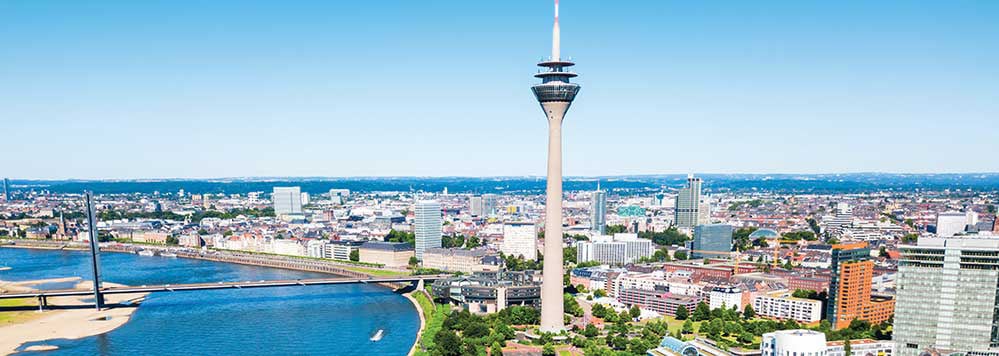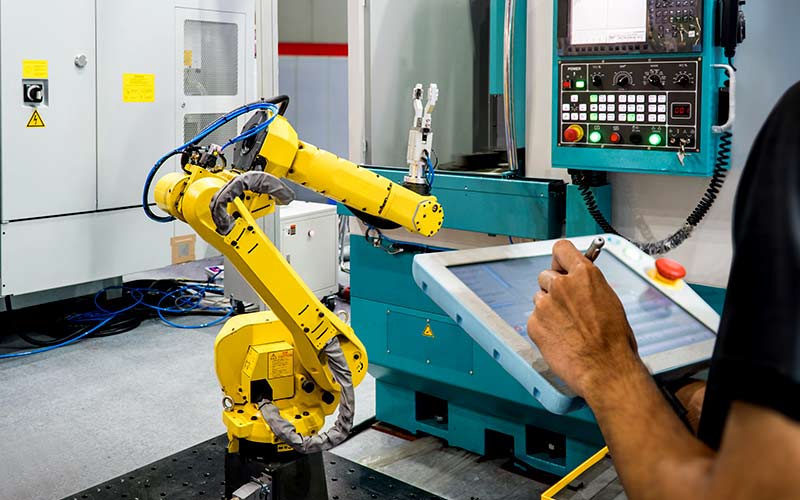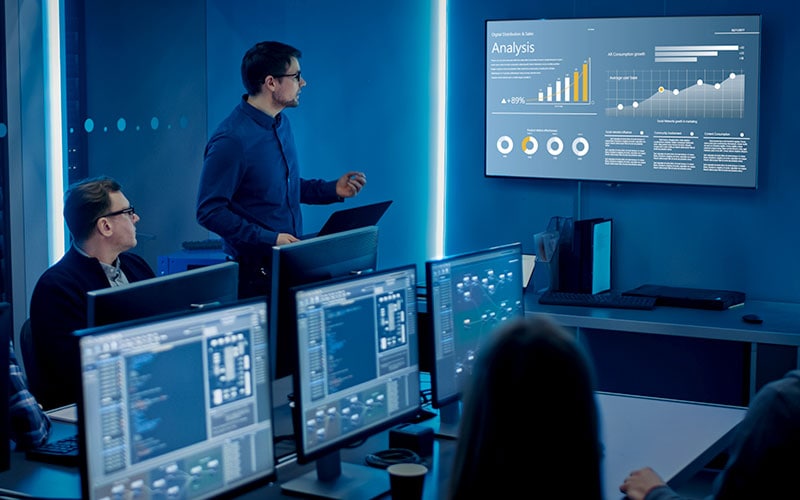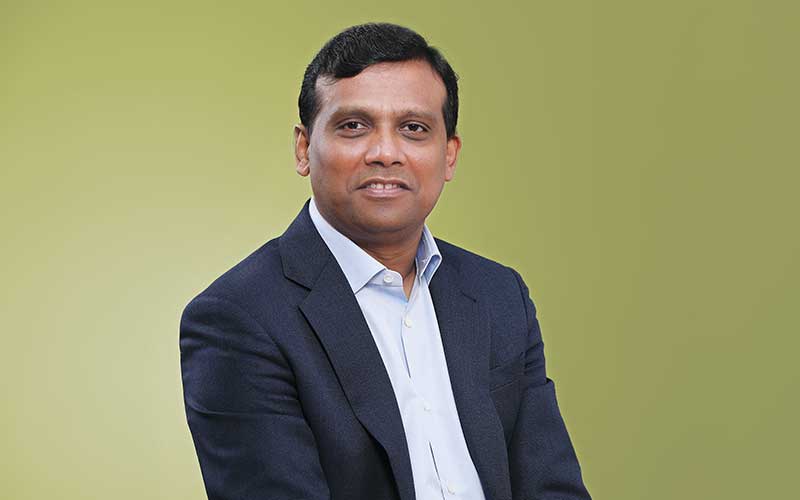
RAVI KUMAR S.
Infosys President and
Deputy Chief Operating Officer
The more global the world becomes, the closer Infosys must be to our clients. The opening of our Strategic Innovation Center in Düsseldorf is yet another step toward helping companies in Europe and beyond meet the demands of the digital age. To do this, Infosys must go beyond offering ready-made solutions and create spaces where we work alongside clients to develop the cutting-edge products and services they need to evolve and compete.
The building chosen for this collaboration, at the corner of Fürstenwall and Friedrichstrasse, represents transformation itself. During its recent renovation, SOP Architects retained the natural stone neo-classical façade of the building – a nod to the city’s past as a part of Prussia in the 1800s, when Düsseldorf became a thriving center for oil, mining, and manufacturing during the Industrial Revolution.
The architects used that façade as an anchor for building out the face of the seven-story structure with massive plates of glass, creating a sleek modern look that reflects the city’s evolution into a high-tech center.
Overlooking the church square in the historic Friedrichstadt district, this location will be home to more than 300 of our 12,000 employees working across Europe. Now a hotspot for digital transformation, Düsseldorf has just the right mix of old and new industries, local feel and global reach. It might be the sixth-largest city in Germany, but it’s the heart of the Rhine-Ruhr region, which boasts the country’s highest GDP. Its central EU location, international airport, highly skilled workforce, strong universities, and collaborative culture are just a few reasons we knew Infosys needed to be here.
On top of that, Düsseldorf’s government leaders aspire to turn it into a smart city by next year. They are well on their way to digitizing public services, building a 5G network, and providing a central portal for the city’s myriad of taxi, rideshare, public transport, and scooter rental apps to improve mobility throughout the city.
Düsseldorf’s drive to become a city of the future mirrors our ambition to turn ourselves and our clients into “live enterprises,” a topic experts will discuss at the grand opening. By embedding AI and agility into core business processes, live enterprises can sense, process, and respond to real-time information across the organization. It’s the next frontier of Industry 4.0 – extending the capabilities of smart factories to the entire corporate environment.
As Infosys continues to build its global network of innovation centers, we wish to thank all of our Düsseldorf government, academic, and corporate partners for joining us on this journey. The closer Infosys is to our clients, the more we understand their aspirations, and the better we can help create digital solutions that improve lives everywhere.
DÜSSELDORF: FROM INDUSTRIAL CENTER TO HIGH-TECH HUB
Düsseldorf isn’t just home to Germany’s first skyscraper and the longest bar in the world, but also 85,000 companies, including 5,000 foreign firms. This industrial center long known for iron, steel, and auto manufacturing has also become a major hub for banking, life sciences, and mobile telecommunications. All that, and its fashion industry rivals those of Paris and Milan. No wonder supermodel Claudia Schiffer was discovered in a Düsseldorf nightclub.
With a population of 640,000, Düsseldorf is the sixth-largest city in Germany and the capital of the Rhine-Ruhr region. Within Europe, it receives more direct foreign investment than any city besides London. More than 30 percent of the EU’s total population lives within 500 kilometers of its city center — a distance a truck can easily travel in a day. Düsseldorf’s central location, international airport, and its collaborative culture are just a few reasons so many businesses, including 350 startups, have set up shop here. Infosys is the latest to join them.
“To thrive in the digital age, your ability to learn and grow must be limitless,” says Gopi Konnanath, senior vice president at Infosys. “Düsseldorf is a city filled with continuous learners. With so many vibrant companies in close proximity, this city was the obvious choice for our newest design center, where we will co-create new solutions with our Germany-based clients and business partners.”
OLD CITY, DEEP ROOTS
This now shining high-tech center on the Rhine began as a tiny dorf on the banks of the River Düssel in the 8th century. Plentiful natural resources and its riverside location helped Düsseldorf grow into a hub for building, trade, and transport. Large manufacturing companies from the neighboring Ruhr region also chose the city for their headquarters, earning Düsseldorf its nickname, “Desk of the Ruhr.”
During WWII, the city was flattened during the Allied bombing campaign. But Düsseldorf regrouped, rebuilt, and soon re-established its economic dominance once more. By the 1950s, it became the center of the German economic miracle, known as the Wirtschaftswunder. In the years that followed, a steady demand for coal and steel cemented Düsseldorf’s economic importance in Germany, Europe and beyond.
Post-WWII, Japan’s huge demand for machinery and heavy industrial products led traders to Düsseldorf, where they acquired manufacturing technology, including knowledge of steel and machine construction. Düsseldorf’s central location in the EU continues to make it the ideal base for Japanese sales and acquisitions in Europe. The city is now home to 480 Japanese companies and the largest Japanese population on the continent. A growing number of Chinese companies are following suit, with 560 now operating in Düsseldorf.
Other investments have come from far and wide. Some 40 consular offices and more than 30 foreign chambers of commerce and foreign trade organizations facilitate business contacts in and around Düsseldorf. Life sciences companies such as Bayer have set up offices here, along with banks and insurance companies like HSBC and Ergo Group. As a result, Düsseldorf’s financial services industry is the second largest in Germany after Frankfurt.
Legal and business consultancies have sprung up alongside these newer commercial residents, as well as hundreds of advertising agencies. Düsseldorf is now home to more creative agencies than Berlin. It’s also become a hub for international trade fairs, hosting more than 50 such events each year. And its fashion scene has made Düsseldorf a high-end shopping destination for foreign tourists.
The convergence of these industries, along with the city’s manufacturing roots, has fueled the region’s growth. The state of North Rhine-Westphalia, where Düsseldorf is the capital, boasts the highest GDP in all of Germany. And Germany’s production leads the EU.
From Düsseldorf, innovation drivers can reach more companies and potential clients than from any other European city.”
A NEW INDUSTRIAL ECONOMY
The industrial heart of Germany has become an example of technological resurgence. The high density and manageable size of Düsseldorf’s economic area — you can get from one end of the city to the other in 10 minutes – offers countless opportunities for companies from both traditional and newer industries to collaborate.
“Your biggest competitors are on the same street as you are, so you talk and work on things together,” says Alex Smolianitski, Düsseldorf’s chief digital officer. “Because people communicate with each other, it’s easier for businesses to scale here.”
Among those businesses are a growing number of Information and Communications Technology (ICT) firms. All three of Germany’s mobile network operators — Telekom, Vodafone, and O2 — are based in Düsseldorf, now a hotspot for digital transformation. Some 1,900 ICT companies employ more than 30,000 people. The digihub, a public-private partnership created to support startups in the NRW region, is also based here.
Throughout the world, the number of startups in the fields of advanced manufacturing and robotics is growing fastest – a trend the startup scene in the Düsseldorf region confirms. The state of NRW is considered the leading location for the development of the Digital Economy and Industry 4.0.
Fed by strong research universities, Düsseldorf’s deep talent pool is another asset. Companies recruit from local universities, and Infosys has longstanding academic partnerships with RWTH Aachen University and WHU Otto Beisheim School of Management to ensure they are equipping graduates with the skills it needs.
A BRIGHT FUTURE ON THE RHINE
The city’s aspirations for the future are bigger than ever. Local leaders plan to transform Düsseldorf into a leading example of a smart city, starting with modernizing the city’s service structure to make e-services, such as registering a car or applying for a visa, fast and straightforward. They are updating the city’s infrastructure to ensure 5G connectivity and making significant investments in education, to the tune of 1 billion euros, to modernize its schools.
In the process, they’ll increase the city’s competitiveness, improve the quality of life, conserve resources, and ensure its future viability. City officials announced their plan for “Smart City Düsseldorf” in January 2017. Once complete, their plans will impact the whole region.
“A smart city doesn’t have borders,” Smoliansitski says. “We have 640,000 citizens. The workforce is 530,000. We have 300,000 people commuting into town, and 100,000 commuting out of town. If you include all the international visitors for trade fairs, we have over 1 million people here during the day. We cannot think about solutions like we are on an island.”
Continued population and economic growth pose a formidable challenge to cities like Düsseldorf: How to move more people through the city as efficiently as possible? Transportation is one of Düsseldorf’s major contributors to CO2 emissions. Smart mobility aims to reduce congestion, CO2, and other emissions — all while helping people get where they need to go. Autonomous cars are already on the horizon. And they’re being built right in the city’s backyard.
Düsseldorf is driving fast toward its future, built on a rich history and vibrant industry, still hard at work today.
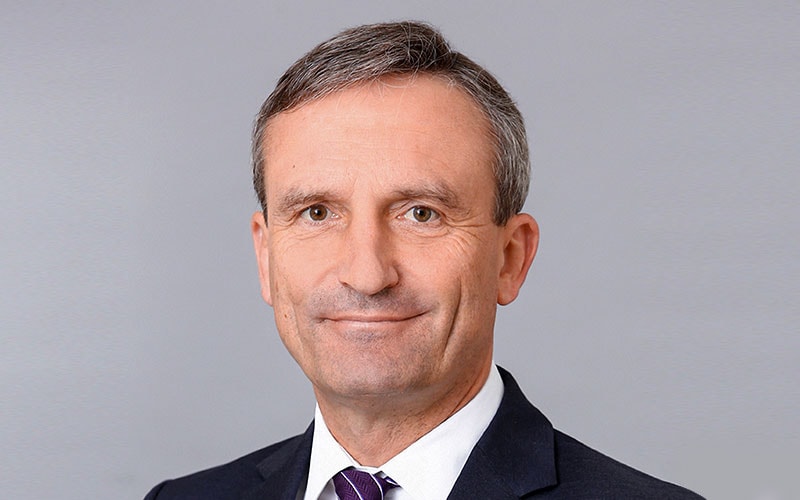

What sets us apart from any other location in Germany and Europe is the huge B2B potential of the business location
INFOSYS FINDS A KINDRED SPIRIT IN DÜSSELDORF
Infosys and Düsseldorf share humble roots. In 1981, seven engineers in Pune, India, founded Infosys with an initial investment of $250. Nearly 40 years later, Infosys is a multinational corporation that provides business consulting, information technology, and outsourcing services to some of the world’s largest companies. It’s the second-largest Indian IT company with 228,000 employees and a market capitalization of $46.52 billion.
Düsseldorf has expanded in countless ways, too. Since 1980, the GDP of North Rhine-Westphalia, the state of which Düsseldorf is the capital, has become the highest in the country, accounting for 21 percent of Germany’s total GDP. It’s the top destination for foreign direct investment in Europe after London, and home to thousands of global companies.
Both have grown with intention, establishing strong international reputations. This year, Infosys was ranked third on Forbes’ list of “The World’s Best Regarded Companies.” Düsseldorf was ranked the sixth most livable city in Mercer’s 2019 Worldwide Quality of Living survey.
Their influence runs both deep and wide. Infosys helps clients in 45 countries navigate their digital transformation. With 82 sales and marketing offices and 123 development centers worldwide, Infosys has a major presence in India, the US, China, Australia, Japan, the Middle East, and Europe. Meanwhile, Düsseldorf sits in the center of the EU and maintains strong business ties with the US, China, and Japan. In fact, more than 450 Japanese banks and corporations have their European headquarters in Düsseldorf.
As Infosys has evolved to become a powerhouse within the tech revolution, Düsseldorf has followed a similar, albeit longer, road to become a high-tech hub in the middle of major industry. That’s by design, explains Düsseldorf Mayor Thomas Geisel. “We have a strong manufacturing sector, cutting-edge technology providers plus access to a great pool of digital and technological talents in an open-minded, international environment,” he says.
That’s why Infosys chose to build its newest development center in Düsseldorf — a city that embraces innovation to transform its manufacturing base into leading examples of Industry 4.0. As part of its commitment to the city, Infosys’ new Düsseldorf Development Center will strengthen its long-standing relationships with local universities to develop digital talent. These include WHU Otto Beisheim School of Management and RWTH Aachen University, among others.
“That’s something unique about Infosys,” says Alex Smolianitski, Düsseldorf’s chief digital officer. “Many international companies just fly in with their people and put them up in huge boarding houses. Infosys understands that they should not only be here but eat locally. They’re hiring locals and partnering with the universities in this region.”
Localization is a big part of Infosys’ business strategy. In recent years, the company’s been building a worldwide network of technology innovation and design centers close to their clients to help them prepare for the digital age. In Düsseldorf, Infosys will serve companies in a range of growing industries, including retail, financial services, telecom, life sciences, and manufacturing.
A COMMON PHILOSOPHY
People are — and should be — the ultimate beneficiaries of technology, argues Infosys Co-Founder and Chairman Nandan Nilekani. During the World Economic Forum’s recent India Economic Summit, he explained how digitalization and affordable data could empower humans on a vast scale. India, he noted, has the largest offline population in the world, despite being the second-largest exporter of information and communication technology services.
“From a social perspective, we should focus on answering ‘How do we make this work at scale for a billion people to improve their lives? How do we leverage this reach to get them better education, better healthcare, and better loans?”
Düsseldorf is asking the same questions. Local leaders aim to make it a leading example of a smart city, using technology to improve the lives of its citizens, workforce, and visitors. Current smart projects include digitizing classrooms for public school students, building a new library with state-of-the-art IT infrastructure, and providing e-services for citizens that will make their lives easier. For example, Düsseldorf residents that would typically have to wait months for an appointment at the Department of Migration can now apply online for travel documents for a family member who is a refugee in another country and receive a response within 24 hours.
BRINGING ENTERPRISE TO LIFE
As technology has evolved, so has Infosys. Just like it’s helped clients become AI-powered models of Industry 4.0 efficiency, Infosys is leading the way in becoming a “live enterprise” applying decades of technical experience and business knowledge to help today’s businesses make automated, agile decisions in real time.
In a live enterprise, all of a company’s IT systems are connected and talking to each other, including those that assess the physical environment and the people working within it. Once connected, the live enterprise can observe how and when people are using that technology and interacting with each other. The system must also be sentient, meaning it can analyze all the data it’s collecting across the organization and make sense of it.
The real power of a live enterprise is the ability to bring it all together and act on that information. A system is alive when it can respond to the connected, observable, and sentient data — and do something about it. Those adjustments happen in real-time, which makes the organization agile. Suddenly, an enterprise moves from manual to automated. And leaders in a live enterprise can feel the pulse of their company, making decisions large and small to make life easier for their teams and their customers.
Making life easier for customers is a principle that Infosys was founded on nearly 40 years ago. Today, this leader of the technology revolution is guiding modern manufacturers and corporations onto a new path. The smarter they become, the more they can transform their enterprises into self-sustaining systems of innovation and advancement.
That’s just as true for Düsseldorf, where Infosys is putting down new roots in fertile ground.
MEET THE DIGITAL CHIEF OF DÜSSELDORF
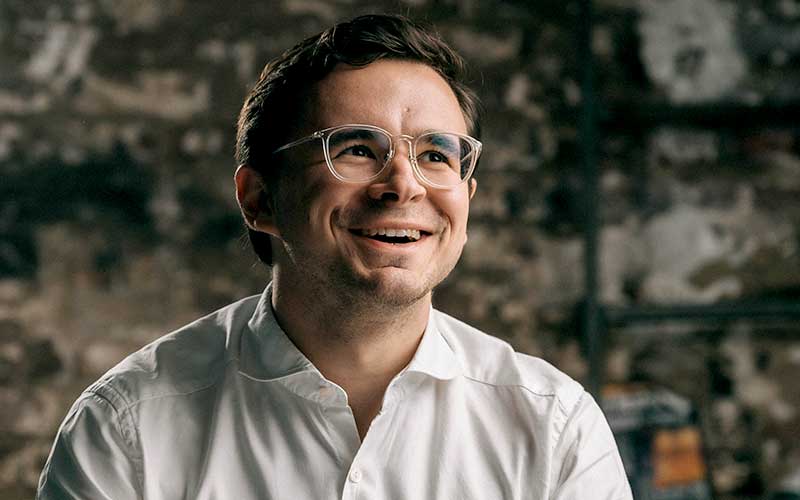
Alex Smolianitski
Chief digital officer – Düsseldorf
Alex Smolianitski, 26, left the private sector in May to become the first chief digital officer of Düsseldorf, where he says he is revolutionizing one of the oldest German products: bureaucracy. As CDO, his primary objective is turning the former industrial center into a smart city, starting with digitizing 75% of the public services that now require physical appointments, such as registering a car or getting a visa, so that citizens can apply online and receive approvals within 24 hours.
BESIDES DIGITIZING CITY SERVICES, WHAT OTHER INITIATIVES HAVE YOU FOCUSED ON SINCE YOU STARTED?
We are building a 5G network throughout the city to enable things like autonomous cars and expect to have 70% city coverage by 2021. We think that 5G should be provided by the city — not the carriers. We are measuring what positions we should build antennas on to provide certain frequencies — from which building, and which light bulb. It’s much more efficient if we do it. Because we think a smart city is not an IT project but a social project that requires having smart citizens, we are also investing in education. We are spending 1 billion euros on modernizing schools and building a new library, which sounds analog, but we see it as a hub for different types of knowledge and city services. It will have free co-working spaces and be open 24-7. Another area we are working on is mobility. In Düsseldorf, we now have four different apps for scooters, three for car sharing, two for taxis, and another two for public transport. We want to connect all of these into one “free market space for mobility” where you enter where you want to go, and it gives you all the options.
WHAT MAKES DÜSSELDORF A PRIME CANDIDATE FOR BECOMING A SMART CITY?
A lot of companies and universities are located here, and people are working. The city’s finances are strong, and we are already a smart city in some ways without the definition. The first 5G call was made in Düsseldorf. What’s really interesting is that 5G is not a topic for mobile coverage. It’s about fiber: 5G has short range, and you need fiber to get frequency. We cannot provide our new fiber network without corporate partners.
TELL US ABOUT YOUR SMART CITY LAB.
It’s a street in the city where we and our partners can try out solutions on the ground — where people walk and trucks park, where there are already light posts and trees. You don’t know if a light is going to be bright enough, if it’s going to measure data you want it to, or if it will interfere with frequencies. No solution is 100%. It takes some trial and error. So, this is our sandbox for trying things out.
WHAT KINDS OF TECHNOLOGY PARTNERS WILL THE CITY NEED DURING THIS TRANSFORMATION?
We don’t need service providers; we need partners. It’s a big difference. I could say I have an issue and throw money at you to provide the solution. Or you can work with me to create the solution. We will have the antennas up and running. We will have autonomic cars because the auto manufacturers are right outside the city. We need things like the connection between cars and people. We need to know what to do next. We need companies that are heavy on development and getting their hands dirty while sitting and drinking a cup of coffee with us.
WHEN WILL YOU BE A SMART CITY?
I think once we have the first project done: interagency e-services for the public. Early next year, the city council will pass the definition of what a “smart city” is to Düsseldorf. We already do smart city projects, and they are not always IT-based. All smart city strategies are about how a society works and lives, together, in a city.
WHERE KNOWLEDGE AND INDUSTRY COMBINE: INVESTING IN GERMANY’S FUTURE
Infosys has a long and proud history of investment and collaboration with leading educational and academic institutions globally. From training and hiring graduates, to collaborating on thought leadership and learning. But it is the company’s German academic partnerships that have been some of the most longstanding and fruitful.
Since 2007, the company has had a close relationship with WHU Otto Beisheim School of Management, Germany’s top-ranking business school, with campuses in Vallendar and Düsseldorf. Infosys forms an integral part of WHU’s band of employers and corporate partners - a total of 29 interns have been part of Infosys’s InStep internship program.
Meanwhile, the school’s professors and faculty work closely with Infosys to pen case studies, speak at conferences and contribute to thought leadership. In fact, Infosys has hosted multiple visits from the University’s management, faculty and students to leadership, learning and knowledge sharing events at the company’s Bangalore headquarters.
This year Infosys expanded its local academic partnership with another Düsseldorf-based institution: HSD Hochschule Düsseldorf University (University of Applied Sciences). The two organizations have agreed a framework under which they can collaborate on research and share insights. But perhaps most important is the launching of the InStep program with HSD in 2020, which will undoubtedly play a large role in helping Infosys to attract and retain local talent from the University to work with the firm.
These two partnerships add to a third longstanding academic relationship, this time with RWTH Aachen University. It is with RWTH that Infosys has collaborated significantly on helping bring forward thinking on Industry 4.0 – a key part of Germany’s high-tech industrial strategy, promoting the computerization of manufacturing for economic growth.
In 2016, Infosys partnered with the Institute for Industrial Management FIR at RWTH to undertake a joint study into global adoption trends and challenges related to Industry 4.0. The findings were published as “Industry 4.0 – State of the Nations” at the Hannover Messe that year. Crucially it was revealed that while 85% of businesses are aware of the potential of Industry 4.0, and nearly half are planning to adopt this model by 2022, the speed of implementation placed 46% of the participants at risk, primarily due to a piecemeal approach with no clear path.
As a result, Infosys worked with acatech (the German Academy of Engineering Sciences), and RWTH, to design an Industry 4.0 Maturity Index, to help organizations plan and accelerate their journey through their transformation to this future state.
Figure 1. Levels of Industry 4.0 maturity
Source: Industrie 4.0 Maturity Index. – Schuh, G., Anderl, R., Gausemeier J., ten Hompel, M., Wahlster, W. (Eds.): Industrie 4.0 Maturity Index. Managing the Digital Transformation of Companies (acatech STUDY), Munich: Herbert Utz Verlag 2017
This index has become a valuable tool for Infosys and its manufacturing clients. Helping them to understand how to plan their investments, select their technologies, and set their strategic objectives as they develop their capabilities to be fully connected Industry 4.0 businesses.
But it also has potential to be used as a strategic tool beyond manufacturing. The codification of Industry 4.0 through the work of RWTH and Infosys on this index has clarified how many different industries and product categories can apply this thinking to their own context. This amplification and extension of ideas and innovations is exactly why Infosys is committed to investing and collaborating with Germany’s leading academic and innovation institutions.
BRINGING INNOVATION TO LIFE
Innovation does not live on a page or in a slideshow. To succeed, new innovations need to be brought to life, tested, tweaked, and proven with real users and real problems. Of course, this comes naturally to Infosys, which is at heart an engineering firm. The company is always pushing the boundaries of technology by applying cutting-edge innovations to real world solutions.
The Strategic Innovation Center in Düsseldorf will not only be a base from which Infosys designs new innovations and works with clients. It will also host a series of technology prototypes and innovation sandboxes within the center, for guests and clients to test out and experience. The center adds to seven centers that already exist in London, Bucharest, Marseille and Berlin in Europe, as well as centers in Indianapolis, Raleigh, Phoenix and Providence in the U.S
Spearheaded by the Infosys Center for Emerging Technologies (iCETS), these Living Labs are where Infosys and its clients collaborate on developing and showcasing joint innovation initiatives. The results of the work to date are accessible to guests in the Düsseldorf center and arranged under key strategic and industry themes on which Infosys is focused.
FUTURE OF MANUFACTURING
Infosys’ Digital Twin Turbine demo showcases a 3D printed turbine that uses Microsoft’s HoloLens. Live sensor data can be superimposed over the virtual twin while the user looks, touches and moves the real turbine. IoT, AI, and AR all work together here to show how heavy asset industry clients can leverage the Infosys AI platform for predictive maintenance of complex pieces of machinery.
Another prototype is a Flight Engine Wash that demonstrates how VR can be used to facilitate training and maintenance of a large, complex piece of expensive machinery for engine wash procedure.
The autonomous material handling showcase brings our experience on robotics and autonomous technologies together. In this example, an automated guided vehicle with a mounted vision-assisted robotic arm will pick up a component in a specified location from a typical manufacturing floor. The automated guided vehicle will autonomously travel to the desired destination, pick up the component and deliver it to the programmed destination.
LIVE ENTERPRISE
A Live Enterprise is one that senses and responds to the environment, able to react to changes on the fly, more like an organism than an organization. It’s also about getting the best out of your talent by reducing process obstacles and enabling more flexibility and speed. It’s a bold futuristic vision for how business should run. But it’s one that Infosys is able to build, tackling each component of a Live Enterprise piece by piece.
Each component represents a specific capability that needs to be developed and designed, linking together with the whole. In the Düsseldorf Center, five of these components are demonstrated through the following prototypes:
Knowledge Graph – A Live Enterprise runs on a “Digital Brain” that is able to elicit information from various repositories and make meaningful decisions in real-time. A Knowledge Graph helps in this process because it can cross analyze multiple structured and unstructured data sources without having to code this into the design of the database structure. Relationships, correlations, clusters – all can be discovered and queried in real-time through a graphical interface.
Infosys Application Management Platform – To be organic and agile, a business needs a nervous system that connects the thoughts to actions, mind to matter. The Business Command Centre prototype shows how it’s possible to connect business capabilities of an enterprise to underlying applications, infrastructure, and network. It’s now possible to relate downtime in an infrastructure element to specific business impact. This helps prioritize resolutions and identify redundancies or bottlenecks. It establishes a linkage from top to bottom from capabilities down to the underlying infrastructure of an organization.
Poly Cloud – The future of digital business is the Cloud. But managing across fragmented cloud platforms is complex and expensive. The next version of the Infosys Cloud Management Platform provides a single portal to manage, provision and monitor workloads across multiple cloud platforms Azure, Google and AWS. The tool provides oversight of applications and utilization of the different cloud systems as well as the ability to manage Cloud budgets holistically.
Configurator Kit – Different people have different work styles, as well as different preferences and requirements depending on the context and situation. For this reason, Infosys has developed Computational Design technologies that automatically change how information is displayed to different users. For example, one manager might like to see charts of annual leave trends for team members, while the other might prefer text insights but with a focus on the impact on productivity in the next two months.
Visitor Management – Here Live Enterprise techniques are used to fix the pain point of welcoming visitors to an office. Trialled in its Bangalore campus, Infosys mapped out a frictionless visitor management journey and what enabling systems support that. Automation techniques were then installed to make that dream a reality. The Live Enterprise approach is not about introducing new technology, but connecting existing disparate components such as room booking, smart space utilisation, guest wifi access, security and compliance checks, wayfinding, and visitor notifications.
SMART SPACES
Infosys Smart Spaces is a comprehensive solution that helps Infosys customers transform people interactions (including those of employees, customers, and other stakeholders) with the physical space and assets leveraging digital technologies.
The company has direct experience of smart building technology first-hand, having implemented and tested many such technologies on its own campuses. There are 1500 sensors implemented across Infosys campuses that track data in real-time and monitor the use of facilities in the campuses. These sensors track usage of electricity and water, monitor water leakage across the buildings and manage humidity levels, temperature and climate control.
For example, Comfy is an app that helps employees manage the climate control in the conference rooms and guest houses on campus. Infosys has also patented a new system for cooling buildings by running cold water through the walls and ceilings, which is 30% more efficient than air conditioning. In Chandigarh, India Infosys has installed a Smart Water metering system that can detect leaks. Smart Utilities is used in Bangalore, which tracks the reprocessing of the sewage water and the quality and cleanliness of the output in real-time. In Mysore, the campus has installed a smart parking system, which helps visitors and employees identify free spaces and track when spaces are available.
FUTURE OF BANKING
Financial services institutions are in constant competition with each other to attract, convert, and retain customers. Customer experience is a key area of focus with customer on-boarding being a very important first step.
One prototype developed for this industry is a simulated persona shows that digital on-boarding using tablet device. The demo explains how Open Banking opens up new distribution channels, including innovative ways to capture new customers by linking accounts to combine fees or improve customers’ access. Open Banking powers account aggregation in real-time and goes beyond offering new products and services. It helps financial service institutions to know their customers well and to provide the best insights.
Another prototype is of a Digital Payments app using Open Banking and Finacle. It showcases the Open Banking, powered by Unified Payment Interface (UPI). UPI leverages existing payments’ infrastructure to provide seamless payment and financial transaction opportunity.
FUTURE OF RETAIL
One of the biggest challenges for retailers today is how to best combine their physical stores with digital experiences in order to provide a seamless and harmonized customer experience across both. The Future of Retail installation shows just how Infosys is doing this by using existing retail infrastructure and “layering” cloud-based micro-services “over the top” to enhance operations and insight gathering.
Representing one component of the larger “Boundless Store” concept, this showcase was built in partnership with a sports fashion brand and used existing CCTV cameras to track the movement of items on a store shelf. The system recognizes when a customer has literally put an item in their basket then adds it to their bill. It can even cope with someone changing their mind — tracking when an item is returned and removing it from their virtual shopping basket.
When the shopper is done, they can just leave with the system charging them for the items virtually. The system can also be used to detect and notify staff of spillages, as well as trigger screens near a shopper that can display content related to the items they’ve picked, such as recipes or other suggested items that match with the shoes or top they’re holding.
FUTURE OF SPORTS
Can you imagine playing against Roget Federer or sitting in the best seats at the French Open in Stade Roland Garros to watch the final? With Infosys’ Future of Sports experience, this is all possible, thanks to a close partnership with the Association of Tennis Professionals that uses the latest virtual reality technology.
Once the user has donned a VR headset, they can watch live games as if they were sitting in the stadium. They can also select and review unique live stats on the game, such as how many times the player serving has won a second serve against a left-handed opponent. Another version of the solution lets a user play against real tennis professionals, using motion capture to judge how they “hit” the ball and return services – if they can! Finally, a merchandising option lets users walk through a virtual street, entering a shop to select, view and buy ATP merchandise, all in 3D virtual reality.
THOUGHT LEADERSHIP
To plan innovation, Infosys must always be trying to predict the future – forecasting how technologies will evolve, and how business challenges will emerge over time. To do this the firm invests in both a “top down” and “bottom up” approach to understanding future changes.
The Infosys Knowledge Institute is the first of these, running large scale and in-depth research programs to understand business challenges by talking with the C-Suite executives that run global businesses. Meanwhile the “bottom up” approach is led by iCETS, which focuses on how technology is being used on the ground, and how new techniques and capabilities are developing over time. This results in the creation of “Trends Tree”, which is available for clients to browse and explore.
This showcase introduces the Talent Radar, an experiential application developed on the basis of an in-depth Infosys Knowledge Institute study. The main objective of this study was to identify the skills required by enterprises for their current and future digital transformation programs. The Talent Radar reveals insights on the talent requirements of organizations that are engaged in digital transformation. It captures the difference in talent perspectives with respect to talent across industries and geographies. It includes a scrutiny of the talent acquisition challenges and the different methods adopted by companies in addressing them.
Another experience is Digital Radar. The experience presents the findings of a research conducted by Infosys and describes how businesses across industries are navigating their digital journeys. It classifies and provides a view into three kinds of organizations namely “Watchers”, “Explorers,” and “Visionaries” based on their approach to digital transformation.
FUTURE OF UTILITIES
The Vegetation Management demo addresses the challenge of the time-consuming data processing. Utilities companies that have networks spreading across vast geographic locations can really struggle with managing the risk that overgrown vegetation can cause to power lines or pipes. It is a major challenge for many utility companies around the globe. Infosys uses deep learning mechanisms, which are based on advanced image processing and image analytics techniques. The time cycle that involves data capturing, data processing and the implementation of a risk mitigation plan takes on average from 4 to 6 years. With Infosys’ solution, the entire time cycle can be reduced to 4 to 6 weeks.
MS LAB
Infosys MS Lab presents several demos. The first demo is Inspection Management - AR/VR Experience. Infosys has mixed reality-based HoloLens App with Azure OCR services and computer vision, which detects and reads the equipment ID from the equipment. It is integrated with Dynamics CRM using Web APIs to read and write data into the CRM and commission diagnostic test scripts. The application running over HoloLens gave the inspection engineers the ability to view detailed specifications of the equipment on-the-go, facilitating avoidance of traditional approach of navigating to various devices and places for equipment check-ups. This helped the customer to drastically lessen costs by reducing the inspection time by 50%.
Another showcase is Infosys’ Drone based automated claim processing. It is AI/ML based solution for Insurance industries. The Drone captures the 360-degree view of the damaged can. Then an AI/ML based model is created with the help of computer vision. After that natural language processing (NLP) will assess the severity of the damage from the image and will create a claim in Microsoft Dynamics 365 Customer Engagement.
As a part of MS Lab, Infosys also presents Platform of Possibilities (POP) and an integrated version of PowerApps. POP envisages core business process empowered by Dynamics 365 business application suit and is supported by next generation of Microsoft technologies. It provides capabilities to register user using biometric registration. It is then logged into the Dynamics 365 application based on biometric verification using facial recognition powered by MS cognitive services. POP helps customers to place the sales order in Dynamics 365 using a chatbot.
An agent can verify the order and record the call summary using voice to text feature of MS cognitive service. It helps in tracking the order using IOT and refund in case of a shipment issue. The agent can then access the service tickets using PowerApps and notification can be sent using MS Flow. Power BI based Service dashboard will be available to the user for service summary.
5G LAB
Infosys Smart Network Assurance (ISNA) is a network analytics and close loop assurance solution that is a tailor-made AI solution for Telecom companies to predict, self-heal, and manage. It can be easily integrated with any physical, virtual, or hybrid network. This flexible proprietary solution facilitates fast and easy interaction with custom data from the telco, building a large repository of reusable insights to improve network services.
Another showcase of 5G lab is a demonstration of 5G RF planning demo-solution. This includes a 3D visualization of buildings, vegetation, roads, sign posts, and traffic signals. It also provides multiple GIS layers for better and flexible analysis. It includes RF Planning analysis using line of sight, Viewshed Analysis, and RF Propagation modelling. The demo-solution can proactively identify affected signal strength and place because of change in GIS information.
